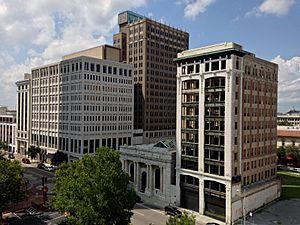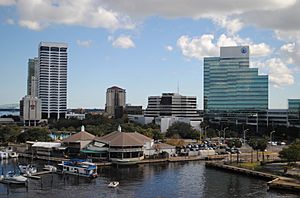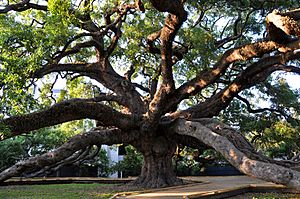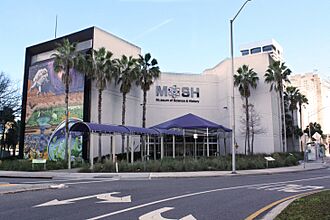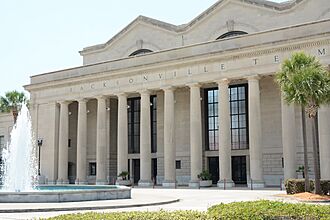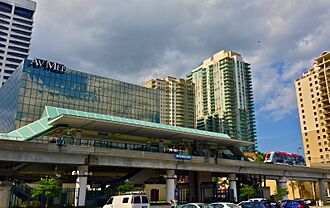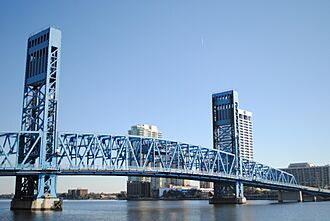Downtown Jacksonville facts for kids
Quick facts for kids
Downtown Jacksonville
|
|
|---|---|
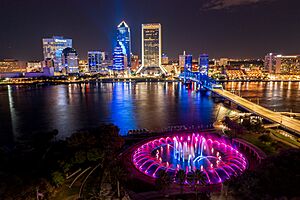
Downtown Jacksonville in 2022
|
|
| Area | |
| • Total | 10.1 km2 (3.91 sq mi) |
| • Land | 7.1 km2 (2.75 sq mi) |
| Population
(2015)
|
|
| • Total | 8,000 |
| • Density | 790/km2 (2,050/sq mi) |
| ZIP Code |
32202,32207
|
| Area code(s) | 904, 324 |
| Website | downtownjacksonville.com |
Downtown Jacksonville is the main part of Jacksonville, Florida. It's like the city's historic heart and where many important businesses are located. It sits right in the middle of the city, along a narrow part of the St. Johns River.
Downtown Jacksonville is one of eight special areas, or districts, in the city. Some of the other districts are the Southbank, LaVilla, and Brooklyn. Many big companies have their main offices here, such as CSX Corporation, Fidelity National Financial, and TIAA Bank.
Contents
History of Downtown Jacksonville
The area where Downtown Jacksonville is today was once a river crossing. Native American tribes like the Seminole called it Wacca Pilatka. Later, British settlers named it the Cow Ford. Some old stories say there was an Indian village here called Ossachite.
White settlers started coming during the time when Florida was ruled by the British (1763–1783). They built a road called the King's Road. This road connected St. Augustine to other British colonies up north. A ferry and a place to eat were built here. When Spain took over Florida again, they built a fort nearby.
In 1822, after Florida became part of the United States, a resident named Isaiah D. Hart suggested starting a town. He convinced his neighbors to give land for the new town. The first streets were planned in June of that year. The town was named "Jacksonville" after Andrew Jackson. He was a famous general who later became president. The town officially became a city in 1832.
The city grew, but it also faced challenges. There were problems during the Second Seminole War (1835–1842). In 1854, a fire from a steamboat burned down the business area. During the American Civil War, Jacksonville was taken over by Union (Northern) soldiers four times. The war caused many people to leave the city.
After the war, Jacksonville quickly became a popular place for tourists. People came to visit Florida. Even though tourism slowed down later, the city continued to grow and develop industries.
On May 3, 1901, a huge fire started at a factory in downtown Jacksonville. This event is known as the Great Fire of 1901. It was one of the biggest fires in the history of Florida. It destroyed the entire business district. About 10,000 people lost their homes. An architect named Henry John Klutho was very important in helping to rebuild the city.
What is Downtown Jacksonville Like?
People use the name "Downtown Jacksonville" in different ways. Sometimes, it means just the old, main part of the city. This area is bordered by State Street to the north and the St. Johns River to the south.
However, the City of Jacksonville uses a wider meaning. This includes the main Downtown area (called the Northbank) and other areas on both sides of the river. This larger area covers about 1,234 acres.
Downtown Jacksonville is divided into several smaller areas or neighborhoods. These include:
Districts of Downtown Jacksonville
Downtown Core (Northbank)
This is the traditional center of Jacksonville. It's what most people think of when they hear "Downtown." Many government offices are here, like City Hall and the Jacksonville Sheriff's Office. You can also find the Main Library and the Museum of Contemporary Art Jacksonville here.
Some of the city's tallest buildings are in the Downtown Core. These include the Bank of America Tower and the Wells Fargo Center. Many big companies have offices in these buildings.
The Downtown Core also has smaller areas:
- The Cathedral District: This area has many important churches. These include St. John's Episcopal Cathedral and the Mount Zion AME Church.
- The Riverfront District: This area is along East Bay Street. It used to be industrial. Now, it has places for fun, businesses, and homes.

Southbank
The Southbank is a mix of businesses and homes. It's on the southern side of the St. Johns River, right across from the Northbank. It's close to the San Marco neighborhood.
You'll find large office buildings here, like the Aetna Building and Riverplace Tower. There are also tall apartment buildings like The Peninsula at St. Johns Center. The Southbank has six major hotels. It's also home to the Museum of Science and History and Friendship Fountain.
LaVilla
LaVilla is a neighborhood just west of the Downtown Core. It was one of Jacksonville's first suburbs. This area was historically a very important center for African-American culture. It had many places where Black performers would entertain, like the Ritz Theatre.
Over time, the neighborhood faced challenges. Many old buildings were lost during city improvement projects. Newer projects are trying to bring more businesses and public spaces back to the area.
Brooklyn
Brooklyn is in the southwest part of downtown. It used to be a neighborhood with many homes. It became part of Jacksonville in 1887. It is connected to the Riverside neighborhood by Riverside Avenue. Big companies like Fidelity National Financial and FIS have their main offices here.
In the 20th century, more businesses and factories moved in. Now, the city is bringing back homes and creating mixed-use areas. These areas have both homes and businesses.
Stadium District
The Stadium District is also called the Sports Complex. It's east of the Downtown Core. This area has Jacksonville's main sports and entertainment places. It's home to EverBank Field, where the Jaguars play football. You can also find the Baseball Grounds of Jacksonville and the Jacksonville Veterans Memorial Arena here.
Nearby Neighborhoods
- Springfield
- Eastside
- Arlington
- St. Nicholas
- San Marco
- Riverside and Avondale
- Mixon Town
- New Town
- Durkeeville
Tall Buildings in Downtown Jacksonville
Downtown Jacksonville has many tall buildings. Here are the 14 tallest ones:
| Rank | Name | Year Built | Location (Downtown) | Floors | Height (feet) | Height (meters) | Notes |
|---|---|---|---|---|---|---|---|
|
1
|
Bank of America Tower | 1990 | North Laura Street & West Bay Street | 42 | 617 | 188 | |
|
2
|
Wells Fargo Center | 1974 | Laura Street & Independent Drive | 37 | 535 | 163 | |
|
3
|
EverBank Center | 1983 | West Bay Street & Pearl Street | 32 | 447 | 136 | |
|
4
|
The Peninsula at St. Johns Center | 2006 | 1401 Riverplace Boulevard | 36 | 437 | 133 | |
|
5
|
Riverplace Tower | 1967 | Riverplace Boulevard & Flagler Avenue | 28 | 432 | 132 | |
|
6
|
SunTrust Tower | 1989 | Laura Street & Independent Drive | 24 | 357 | 109 | |
|
7
|
The Strand at St. Johns Center | 2006 | 1401 Riverplace Boulevard | 28 | 328 | 100 | |
|
8
|
Aetna Building | 1954 | 841 Prudential Drive | 22 | 309 | 94 | |
|
9
|
Two Prudential Plaza | 1985 | Museum Circle & San Marco Boulevard | 21 | 305 | 93 | |
|
10
|
One Enterprise Center | 1986 | Water & Hogan Streets | 21 | 299 | 91 | |
|
11
|
Blue Cross Blue Shield Building | 1971 | Riverside Avenue & Edison Street | 19 | 287 | 87 | |
|
12
|
BB&T Building | 1974 | West Forsyth & Hogan Streets | 18 | 278 | 85 | |
|
13
|
John Milton Bryan Simpson United States Courthouse | 2002 | West Duval & Hogan Streets | 15 | 277 | 84 | |
|
14
|
JEA Tower | 2005 | West Church & Main Streets | 19 | 268 | 82 |
Parks and Plazas
Downtown Jacksonville has many parks and open spaces. These are great for relaxing and enjoying nature:
- Brooklyn Park
- Courthouse Lawn
- Friendship Fountain
- James Weldon Johnson Park
- Metropolitan Park
- Northbank Riverwalk
- Southbank Riverwalk
- Plaza at TIAA Bank Center
- Treaty Oak Park
Fun Things to Do in Downtown Jacksonville
Downtown Jacksonville has many attractions for visitors:
- TIAA Bank Field (home of the Jacksonville Jaguars football team)
- Baseball Grounds of Jacksonville (for baseball games)
- Jacksonville Veterans Memorial Arena (for concerts and events)
- Prime F. Osborn III Convention Center
- Museum of Contemporary Art Jacksonville (MOCA)
- Museum of Science and History (MOSH)
- Jacksonville Fire Museum
- Ritz Theatre & Museum
- Florida Theatre
- Times-Union Center for the Performing Arts
Getting Around Downtown Jacksonville
You can get around Downtown Jacksonville using buses, the Skyway, or water taxis. There are also major roads for cars.
Public Transportation
The Jacksonville Transportation Authority (JTA) runs a free public transport system. It's called the Skyway. This is an automated train system that runs above the streets. There's also a large bus network.
Here are the Skyway stations:
- Rosa L. Parks/FSCJ (serves Florida State College at Jacksonville)
- James Weldon Johnson Park (serves City Hall and the Main Library)
- Central (serves TIAA Bank Center and the Omni Hotel)
- Jefferson (serves the Federal Reserve Building)
- Convention Center (serves the Prime F. Osborn III Convention Center)
- San Marco (serves the Museum of Science and History)
- Riverplace (serves Riverplace Tower)
- Kings Avenue (the last stop on the Skyway line)
Downtown is also where you'll find the main bus station for Greyhound.
Bridges
Jacksonville is often called "The River City." This is because the St. Johns River is very important to the city. Downtown is located where the river gets narrower before it flows into the Atlantic Ocean. Because of this, there are many bridges in the downtown area. Five bridges connect the two sides of Duval County right in Downtown:
- Fuller Warren Bridge
- Acosta Bridge
- Main Street Bridge
- Hart Bridge
- Mathews Bridge
Highways
Several major highways lead to Downtown Jacksonville from other parts of Florida:
- I-10 (from Baldwin)
- I-95 North (from the airport area)
- I-95 South (from St. Augustine)
- Arlington Expressway (from the Beaches)
- Hart Expressway (from the Southside area)
Other important roads include U.S. Route 1, U.S. Route 17, and U.S. Route 90. Downtown is also the end point for U.S. Route 23.
See also
 In Spanish: Downtown Jacksonville para niños
In Spanish: Downtown Jacksonville para niños




